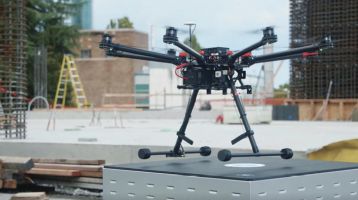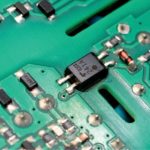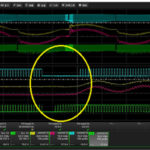Buck-boost regulators efficiently power wireless charging stations for mobile robots.
Logistics, delivery and inspection industries increasingly rely on mobile robotic fleets. These fleets have become large enough that their users are trying to find ways of recharging them that don’t rely on human operators.

One means of automating the robotic charging process is through use of equipment from WiBotic. The approach is to build wireless charging hardware into the robotic platform. The charging hardware sends the bot to a charging station when it senses the battery needs a charge. The bot positions itself near the charging station in a way that aligns transmitting and receiving coils for power transfer.
The various possible configurations of ambulatory and flying robotic platforms complicate the design of the

charging apparatus. Today, there are several ways of wirelessly charging batteries. The most common is inductive charging as is typical in cell phones. But inductive systems are only efficient when the antennas are extremely close. It’s tough to design robots and drones to position themselves accurately enough for reliable charging. Magnetic resonance charging offers more flexible positioning but has a relatively small sweet spot for maximum transfer efficiency.
WiBotic technology incorporates both inductive and resonant systems via what’s called an Adaptive Matching system. It constantly monitors relative antenna position and dynamically adjusts both hardware and firmware parameters to maintain maximum energy transfer efficiency across several centimeters of vertical, horizontal and angular offset. An embedded identification and communication system lets any robot charge from any station, even if the robots have different battery chemistries, voltages, and charging rates.

APIs from WiBotic let computers on the same network as the transmitter monitor charging and set charging parameters. For example, operators might schedule robots for charging at their highest power level when they’re busy, but more slowly overnight to maximize battery lifespan.
WiBotic chargers must carefully manage charging modes to optimize up-time while not degrading batteries through repetitive quick charges. This variability in charging cycles and power levels – from 300 W for fast charging to 100 mW trickle-charging – also requires a power delivery architecture that matches a wide range of impedances. To efficiently accommodate the wide range of loads, WiBotic used a Vicor zero-voltage switching (ZVS) buck-boost PRM regulator. Its topology enables a high switching frequency (about 1MHz). High switching frequency reduces the size of reactive components, enabling a power density of up to 1,383 W/in3. The Vicor regulator is integrated into the RF transmitter onboard the WiBotic TR-110 wireless charging station. The 48-V input (the regulator accepts a 36–75-Vdc range) is from an ac-dc power supply. The output voltage is dynamically controlled and trimmed from approximately 20 to 55 V as needed.

The Vicor PRM handles full-charge and trickle-charge modes with no significant drop-off at lower power levels–a critical performance benchmark that defeated competing power components—as well as a ‘topping-off’ mode requiring a constant voltage for a 100% charge. High-efficiency conversion yielded a maximum operating temperature of 45°C. The TR-110 wireless charging station employs active cooling to dissipate heat from the onboard RF amplifier, but the Vicor surface-mounted PRM sits outside this airflow.
The zero-cross switching of the Vicor PRM module also minimized EMI/noise challenges and conducted emission/EMC requirements with no need for additional filters.
The PRM is in a surface-mount package measuring 1.28×0.87×0.249 in [32.5×22.0x6.31 mm] which is compatible with standard pick-and-place and surface-mount assembly processes. It also provides a planar thermal interface area to enhance thermal conductivity. The compact size of the PRM helps keep the onboard charger small and light weight, thus promoting long operating cycles particularly for airborne fleets. For the stationary wireless charging stations, a dense power delivery architecture ultimately helps conserve valuable real estate in the deployment environment.







Leave a Reply